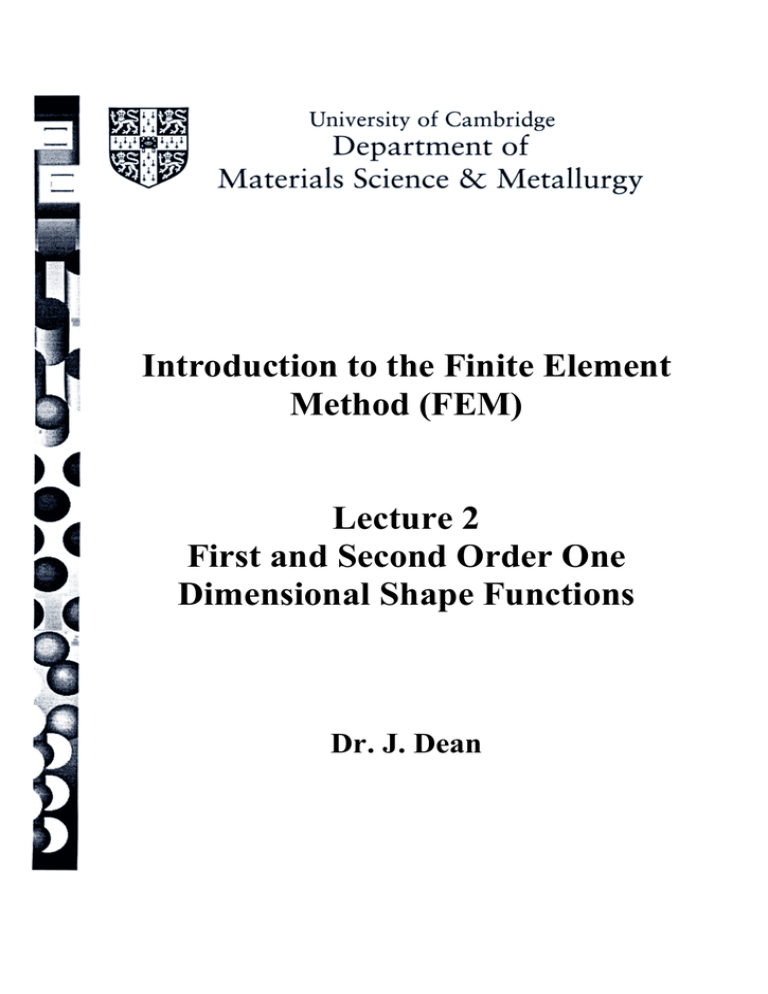First and second order one-dimensional shape functions
advertisement

Introduction to the Finite Element Method (FEM) Lecture 2 First and Second Order One Dimensional Shape Functions Dr. J. Dean Discretisation Consider the temperature distribution along the one-dimensional fin in Fig.1. Figure 1: Depiction of a piecewise approximation to a continuous function A one-dimensional continuous temperature distribution with an infinite number of unknowns is shown in (a). The fin is discretised in (b) – i.e. divided into 4 subdomains (or elements). The nodes are numbered consecutively from left to right, as are the elements. The elements are first order elements; the interpolation scheme between the nodes is therefore linear. Note that there are only 5 nodes for this system, since the internal nodes are shared between the elements. Since we are only solving for temperature, there are only 5 degrees of freedom in this model of the continuous system. It should be clear that a better approximation for T(x) would be obtained if the number of elements was increased (i.e. if the element lengths were reduced). It is also apparent that the nodes should be placed closer together in regions where the temperature (or any other unknown solution) changes rapidly. It is useful also to place a node wherever a step change in temperature is expected and where a numerical value of the temperature is needed. It is good practice to continue to increase the number of nodes until a converged solution is reached. In (c), the fin has been divided into two subdomains – elements 1 and 2. However, in this instance we have chosen to use a second order (quadratic) element. These elements contain ‘midside’ nodes as shown, and the interpolation between the nodes is quadratic which permits a much closer approximation to the real system. For this model system there are still just 5 degrees of freedom. However, the analysis takes longer for (c) than it does for (b) because the quadratic interpolation (which calculates the temperature at locations between the nodes) is more demanding than the corresponding linear case.1 (There is often a trade-off between a high number of first order elements requiring little computation and a smaller number of second order elements requiring more heavy computation to be made, which affects both the analysis time and the solution accuracy. The choice depends to a large extent on the problem being solved.) 1 For a system with only 5 degrees of freedom the difference would be imperceptible using modern desktop machines. This would not be the case for large systems containing hundreds of thousands of degrees of freedom. 1 Shape Functions We can use (for instance) the direct stiffness method to compute degrees of freedom at the element nodes. However, we are also interested in the value of the solution at positions inside the element. To calculate values at positions other than the nodes we interpolate between the nodes using shape functions. A one-dimensional element with length L is shown in Fig.2. It has two nodes, one at each end, denoted i and j, and known nodal temperatures T i and T j . We can deduce automatically that the element is first order (linear) since it contains no ‘midside’ nodes. Figure 2: One dimensional linear element with temperature degrees of freedom We need to derive a function to compute values of the temperature at locations between the nodes. This interpolation function is called the shape function. We demonstrate its derivation for a 1-dimensional linear element here. Note that, for linear elements, the polynomial inerpolation function is first order. If the element was second order, the polynomial function would be second order (quadratic), and so on. Since the element is first order, the temperature varies linearly between the nodes and the equation for T is: 𝑇(𝑥) = 𝑎 + 𝑏𝑥 (1) 2 We can therefore write: (2) 𝑇𝑖 = 𝑎 + 𝑏𝑋𝑖 𝑇𝑗 = 𝑎 + 𝑏𝑋𝑗 (3) 𝑇𝑖 −𝑎 (4) which are simultaneous. To determine the coefficients 𝑎 and 𝑏: =𝑏 𝑋𝑖 𝑇𝑗 −𝑎 (5) =𝑏 𝑋𝑗 𝑇𝑖 −𝑎 = 𝑋𝑖 𝑇𝑗 −𝑎 (6) 𝑋𝑗 (𝑇𝑖 − 𝑎)𝑋𝑗 = �𝑇𝑗 − 𝑎�𝑋𝑖 (7) 𝑇𝑖 𝑋𝑗 − 𝑇𝑗 𝑋𝑖 = 𝑎�𝑋𝑗 − 𝑋𝑖 � (9) (8) 𝑇𝑖 𝑋𝑗 − 𝑎𝑋𝑗 = 𝑇𝑗 𝑋𝑖 − 𝑎𝑋𝑖 𝑇𝑖 𝑋𝑗 −𝑇𝑗 𝑋𝑖 = 𝑎 (10) = 𝑎 (11) 𝑇𝑖 − 𝑏𝑋𝑖 = 𝑎 (12) 𝑇𝑖 − 𝑏𝑋𝑖 = 𝑇𝑗 − 𝑏𝑋𝑗 (14) 𝑏�𝑋𝑗 − 𝑋𝑖 � = 𝑇𝑗 − 𝑇𝑖 (16) �𝑋𝑗 −𝑋𝑖 � 𝑇𝑖 𝑋𝑗 −𝑇𝑗 𝑋𝑖 and 𝐿 𝑇𝑗 − 𝑏𝑋𝑗 = 𝑎 (13) 𝑏𝑋𝑗 − 𝑏𝑋𝑖 = 𝑇𝑗 − 𝑇𝑖 (15) 𝑇 −𝑇 𝑏 = �𝑋𝑗−𝑋𝑖 � 𝑗 𝑏= 𝑇𝑗 −𝑇𝑖 (17) 𝑖 (18) 𝐿 Substitution of Eqns.11 and 18 into Eqn.1 yields: 𝑇(𝑥) = 𝑇(𝑥) = 𝑇𝑖 𝑋𝑗 −𝑇𝑗 𝑋𝑖 𝐿 𝑇𝑖 𝑋𝑗 −𝑇𝑗 𝑋𝑖 𝐿 𝑇𝑗 −𝑇𝑖 +� + 𝐿 �𝑥 𝑇𝑗 𝑥−𝑇𝑖 𝑥 𝐿 (19) (20) 3 𝑇(𝑥) = 𝑇(𝑥) = 𝑇 𝑖 𝑋𝑗 𝐿 𝑇 𝑖 𝑋𝑗 𝐿 − − 𝑇 𝑗 𝑋𝑖 𝐿 𝑇𝑖 𝑥 𝐿 + 𝐿 𝑋𝑗 −𝑥 𝑇(𝑥) = 𝑇𝑖 � + 𝑇𝑗 𝑥 𝐿 𝑇𝑗 𝑥 𝐿 � + 𝑇𝑗 � − − 𝑇𝑖 𝑥 (21) 𝑇 𝑗 𝑋𝑖 (22) 𝑥−𝑋𝑖 𝐿 𝐿 𝐿 (23) � It should be clear from Eqn.23 that the nodal temperature values are multiplied by linear functions of 𝑥 – the shape functions. The functions are denoted by 𝑆 with a subscript to indicate the node with which a specific shape function is associated. In the case presented: 𝑋𝑗 −𝑥 𝑆𝑖 = � 𝐿 𝑥−𝑋𝑖 𝑆𝑗 = � 𝐿 � (24) Draw linear shape functions (25) � And Eqn.23 becomes (26) 𝑇(𝑥) = 𝑆𝑖 𝑇𝑖 + 𝑆𝑗 𝑇𝑗 In matrix form 𝑇𝑥𝑒 = [𝑆𝑖 𝑇 𝑆𝑗 ] � 𝑖 � 𝑇𝑗 (27) For the case shown in Fig.3, calculate 𝑇at 𝑥 = 3.3 𝑇(𝑥 = 3.3) = 𝑇𝑖 � 𝑋𝑗 −𝑥 𝐿 5−3.3 𝑇(𝑥 = 3.3) = 50 � 𝑇(𝑥 = 3.3) = 50.6 2 𝑥−𝑋𝑖 � + 𝑇𝑗 � 𝐿 � 3.3−3 � + 54 � 2 � Figure 3: 1-dimensional linear element with known nodal temperatures and positions 4 From inspection of Eqn.26 we can deduce that each shape function has a value of 1 at its own node and a value of zero at the other nodes. The sum of the shape functions sums to one. The shape functions are also first order, just as the original polynomial was. The shape functions would have been quadratic if the original polynomial has been quadratic. A continuous, piecewise smooth equation for the one dimensional fin first shown in Fig.1 can be constructed by connecting the linear element equations. We know that the temperature at any point in any element can be found from the nodal temperatures 𝑇𝑖 and the shape functions, 𝑆𝑖 . For the following system: 𝑇𝑥𝑒 = 𝑆𝑖 𝑇𝑖 + 𝑆𝑗 𝑇𝑗 (28) 𝑋𝑖 ≤ 𝑥 ≤ 𝑋𝑗 Node Element # 1 2 3 4 𝑋 −𝑥 𝑇𝑥1 = 𝑆11 𝑇1 + 𝑆21 𝑇2 𝑆11 = 𝑋 2−𝑋 2 1 3 2 4 3 5 4 𝑋 −𝑥 𝑇𝑥2 = 𝑆22 𝑇2 + 𝑆32 𝑇3 𝑆22 = 𝑋 3−𝑋 𝑋 −𝑥 𝑇𝑥3 = 𝑆33 𝑇3 + 𝑆43 𝑇4 𝑆33 = 𝑋 4−𝑋 𝑋 −𝑥 𝑇𝑥4 = 𝑆44 𝑇4 + 𝑆54 𝑇5 𝑆44 = 𝑋 5−𝑋 𝑆21 ≠ 𝑆22 , 𝑆32 ≠ 𝑆33 and 𝑆43 ≠ 𝑆44 𝑥−𝑋1 𝑆21 = 𝑋 2 −𝑋1 𝑥−𝑋2 𝑆32 = 𝑋 3 −𝑋2 𝑥−𝑋3 𝑆43 = 𝑋 4 −𝑋3 𝑥−𝑋4 𝑆43 = 𝑋 5 −𝑋4 𝑋𝑗 −𝑥 𝑇𝑥𝑒 = 𝑇𝑖 � 𝑇𝑥𝑒 = 𝑇𝑥𝑒 = 𝑋𝑗 𝑇 𝑖 𝐿 𝑥𝑇𝑗 𝐿 𝑥 𝐿 − − 𝑥−𝑋𝑖 � + 𝑇𝑗 � 𝑥𝑇𝑖 𝐿 𝑥𝑇𝑖 𝐿 + + 𝑥𝑇𝑗 𝐿 𝑋𝑗 𝑇 𝑖 𝐿 1 𝐿 + − � j 1 2 3 4 2 3 4 5 𝑋1 ≤ 𝑥 ≤ 𝑋2 (29) 𝑋3 ≤ 𝑥 ≤ 𝑋4 (31) 𝑋2 ≤ 𝑥 ≤ 𝑋3 (30) 𝑋4 ≤ 𝑥 ≤ 𝑋5 (32) The temperature gradient through the an individual element derivative of Eqn.33 i 𝑑𝑇 𝑒 𝑑𝑥 can be found from the (33) 𝑋𝑖 𝑇 𝑗 (34) 𝑋𝑖 𝑇 𝑗 (35) 𝐿 𝐿 𝑇𝑥𝑒 = 𝐿 �𝑇𝑗 − 𝑇𝑖 � + 𝐿 �𝑋𝑗 𝑇𝑖 − 𝑋𝑖 𝑇𝑗 � (36) 5 such that 𝑑𝑇𝑥𝑒 𝑑𝑥 = 𝑇𝑗 −𝑇𝑖 (37) 𝐿 We can check that our shape functions are correct by knowing that the shape function derivatives sum to zero. 1-Dimensional Quadratic Elements A one-dimensional quadratic element is shown in Fig.4. We can deduce immediately that the element order is greater than one because the interpolation between the nodes in nonlinear. We can determine from inspection that the element is quadratic (second order) because there’s a ‘midside’ node. We know therefore that the function approximating the solution is a second order polynomial: 𝑇𝑥𝑒 = 𝑎 + 𝑏𝑥 + 𝑐𝑥 2 (38) x The shape functions 𝑆𝑖 can be determined by solving Eqn.38 using known 𝑇𝑖 at known 𝑋𝑖 to give: 𝑇𝑥𝑒 = 𝑆𝑖 𝑇𝑖 + 𝑆𝑗 𝑇𝑗 + 𝑆𝑘 𝑇𝑘 𝑗 2 𝑆𝑖 = 𝐿2 (𝑥 − 𝑋𝑘 )�𝑥 − 𝑋𝑗 � 𝑆𝑗 = −4 𝐿2 2 (𝑥 − 𝑋𝑖 )(𝑥 − 𝑋𝑘 ) 𝑆𝑘 = 𝐿2 (𝑥 − 𝑋𝑖 )�𝑥 − 𝑋𝑗 � (39) (40) (41) (42) 6 Using the quadratic shape functions for a single element (Eqns.40-42), we can assemble a corresponding set of equations for a larger system: Element # 1 Element # 2 𝑇𝑥1 𝑇𝑥2 𝑇𝑥1 = 𝑆𝑖1 𝑇𝑖 + 𝑆𝑗1 𝑇𝑗 + 𝑆𝑘1 𝑇𝑘 = �𝑆𝑖1 = [𝑆𝑘2 𝑆𝑘1 2 𝑆𝑚 i i Nodes j j k k i k Nodes j m k n 𝑇𝑖 1 𝑆𝑗 � �𝑇𝑘 � 𝑇𝑗 𝑇𝑘 2 ] �𝑇 � 𝑆𝑛 𝑚 𝑇𝑛 (43) 2 𝑆𝑖1 = 𝐿2 (𝑥 − 𝑋𝑘 )�𝑥 − 𝑋𝑗 � 𝑆𝑗1 = −4 𝐿2 2 (𝑥 − 𝑋𝑖 )(𝑥 − 𝑋𝑘 ) 𝑆𝑘1 = 𝐿2 (𝑥 − 𝑋𝑖 )�𝑥 − 𝑋𝑗 � 2 𝑇𝑥2 = 𝑆𝑘2 𝑇𝑘 + 𝑆𝑚 𝑇𝑚 + 𝑆𝑛2 𝑇𝑛 (44) 2 𝑆𝑘2 = 𝐿2 (𝑥 − 𝑋𝑛 )(𝑥 − 𝑋𝑚 ) 2 𝑆𝑚 = −4 𝐿2 2 (𝑥 − 𝑋𝑘 )(𝑥 − 𝑋𝑛 ) 𝑆𝑛2 = 𝐿2 (𝑥 − 𝑋𝑘 )(𝑥 − 𝑋𝑚 ) 7 The element shape functions are stored within the element in commercial FE codes. The positions 𝑋𝑖 are generated (and stored) when the mesh is created. Once the nodal degrees of freedom are known, the solution at any point between the nodes can be calculated using the (stored) element shape functions and the (known) nodal positions. The nodal degrees of freedom are calculated using a method such as that shown previously in lecture 1. For the cases presented above, simple 1-dimensional elements were most appropriate, but for many practical applications we may encounter more complex 2- and 3-dimensional geometry. A suitable set of element types are shown in Fig.4 encompassing a range of geometry and element order. A meshed geometry is shown in Fig.5. Figure 4: Example element types Figure 5: An exhaust manifold discretised (meshed) using 3-dimensional, quadratic brick elements, enabling the geometrical curvature to be captured 8 Coordinate Systems Solution fields (such as displacement fields in solid mechanics) often require integrals of the following kind to be evaluated: 𝑋 𝑋 ∫𝑋 𝑗 𝑆𝑖 (𝑥)𝑆𝑗 (𝑥)𝑑𝑥 or ∫𝑋 𝑗 𝑆𝑖2 (𝑥)𝑑𝑥 𝑖 (45) 𝑖 Note that the superscript in Eqn.45 denotes a power now (and not an element label). These integrals can be simplified to make the integration procedures more efficient by deriving new shape functions defined relative to a local (element level) coordinate system. For instance, we have so far derived our one-dimensional linear shape functions using a global coordinate system with its origin at O – Fig.6. These shape functions were: 𝑋𝑗 −𝑥 𝑆𝑖 (𝑥) = � 𝑆𝑗 (𝑥) = � 𝐿 𝑥−𝑋𝑖 𝐿 (46) � (47) � x s Figure 6: Representation of a single linear element in global, local and natural frames of reference We wish now to derive the shape functions in the local coordinate reference frame with the origin at 𝑋𝑖 - shown also in Fig.6. In the new reference frame the position along the element given previously by 𝑥 is now given by 𝑋𝑖 + 𝑠. We can rewrite the shape functions in Eqns.46 and 47 using the new reference frame by substitution such that: 9 𝑆𝑖 (𝑠) = 𝑆𝑗 (𝑠) = 𝑋𝑗 −(𝑋𝑖 +𝑠) 𝐿 (𝑋𝑖 +𝑠)−𝑋𝑖 𝐿 and 𝑠 (48) =1−𝐿 𝑠 (49) =𝐿 𝑋 𝑋 𝑗 𝑗 ∫𝑋 𝑆𝑖 (𝑥)𝑆𝑗 (𝑥)𝑑𝑥 or ∫𝑋 𝑆𝑖2 (𝑥)𝑑𝑥 𝑖 (50) 𝑖 becomes 𝐿 𝐿 ∫0 𝑆𝑖 (𝑠)𝑆𝑗 (𝑠)𝑑𝑠 or ∫0 𝑆𝑖2 (𝑠)𝑑𝑠 (51) where the limits of integration are easier to deal with. However, they can be simplified further by using a non-dimensional natural coordinate system. A natural coordinate system is shown in Fig.6. A coordinate at the centre of the element is specified. From this reference frame, the shape functions are: 1 (52) 1 (53) 𝑆𝑖 (𝜉) = 2 (1 − 𝜉) 𝑆𝑗 (𝜉) = 2 (1 + 𝜉) 𝐿 To find these, we substitute 𝑥 in Eqns.46 and 47 with 𝑥 = 𝑋𝑖 + 2 + 𝜉 and note that 𝐿 = 2 𝑆𝑖 (𝜉) = 𝑆𝑗 (𝜉) = 𝑋𝑗 −𝑥 𝐿 𝑥−𝑋𝑖 𝐿 = = 𝐿 2 𝑋𝑗 −�𝑋𝑖 + +𝜉� 𝐿 2 𝐿 �𝑋𝑖 + +𝜉�−𝑋𝑖 𝐿 = = 𝑋𝑗 𝐿 𝑋𝑖 𝐿 − 𝑋𝑖 𝐿 𝐿 𝐿 𝜉 1 𝜉 1 (54) 1 𝜉 1 (55) − 2𝐿 − 𝐿 = 2 − 2 = 2 (1 − 𝜉) 𝜉 + 2𝐿 + 𝐿 − 𝑋𝑖 𝐿 = 2 + 2 = 2 (1 + 𝜉) Recall that the shape functions are equal to one at their respective nodes and 0 at the other nodes – i.e: 1 𝑆𝑖 (−1) = 2 (1 − 𝜉) = 1 𝑆𝑖 (1) = 1 (1 − 𝜉) = 0 2 1 𝑆𝑗 (−1) = (1 − 𝜉) = 1 2 1 𝑆𝑗 (1) = (1 − 𝜉) = 0 2 The integrals become: 1 1 ∫−1 𝑆𝑖 (𝜉)𝑆𝑗 (𝜉)𝑑𝜉 or ∫−1 𝑆𝑖2 (𝜉)𝑑𝜉 (56) 10 where the limits of integration are -1 and +1. Integrals of this type can be solved very efficiently using, for instance, the Gauss-Legendre method. 11




